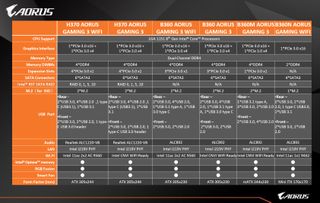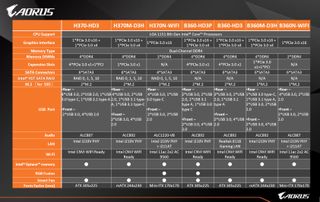Gigabyte Reveals 13 New Intel H370, B360 Motherboards

Intel’s less-expensive 300-series chipsets are finally here, and Gigabyte is leading the charge with 13 new motherboards.
The company announced five H370 and eight B360 motherboards, with Gigabyte seemingly betting on the less-expensive B-series budget boards to have a broader appeal. All of the new boards support Intel’s 8th generation Coffee Lake processors. Although Intel also announced the H310 chipset, Gigabyte doesn’t appear to have one at the ready for the launch, but it certainly made up for it in numbers.
Aorus Motherboards
Gigabyte revealed six new Aorus-branded 300-series motherboards. The two H370 motherboards are completely identical save for a fairly obvious feature (the Wi-Fi). The H370 Aorus Gaming 3 and Gaming 3 WiFi both sport an ATX form factor with two PCIe x16 slots (one PCIe 3.0 x 16, one PCIe 3.0 x4), four PCIe 3.0 x1, and four 288-pin DDR4 memory slots for dual-channel setups. The storage options are also the same, with two M.2 interfaces (one PCIe 3.0 x 4, one PCIe 3.0 x 2 / SATA) and six SATA 6Gb/s ports that support RAID 0, 1, 5, and 10.
The B360 Aorus Gaming 3 and Gaming 3 WiFi, the B360M Aorus Gaming 3, and the B360N Aorus Gaming WiFi all feature an Intel B360 chipset. The B360 Gaming 3 and Gaming 3 WiFi are ATX boards, and the B360M Gaming 3 and B360N Gaming WiFi are micro-ATX and mini-ITX, respectively. The ATX-sized B360 boards offer the same storage and PCIe x16 connectivity as the H370 boards (detailed above), but it has one less PCIe 3.0 x1 slot, and the B360 chipset does not support RAID configurations. The micro-ATX B360M Aorus Gaming 3 trims two more PCIe 3.0 x 1 slots (for one total), and the mini-ITX B360N Gaming WiFi shaves off an M.2 slot, two SATA 6GB/s ports (four total), and the PCIe 3.0 x4 slot, in addition to two of its memory DIMM sockets (two total).

USB connectivity between the Aorus-branded ATX 300-series boards is also the same across the stack, with the Gaming 3 and Gaming 3 WiFi (both H370 and B360) sporting two USB 3.1 (Gen 1) (one Type-A, one Type-C), two USB 3.0, and four USB 2.0 ports. They can also accommodate two USB 3.0 and two USB 2.0 ports on the front panel from the internal headers. The micro-ATX B360M Gaming 3 ditches the Type-C interface and changes the port configuration to a single USB 3.1 Type-A, three USB 3.0, and two USB 2.0 ports. The B360N Aorus Gaming WiFi is also different, with a USB 3.0 Type-C, one USB 3.1 Type-A, two USB 3.0, and two USB 2.0 ports. The smaller motherboards retain the same front panel USB capabilities as their larger counterparts.
The Others
Gigabyte also debuted seven non-Aorus-branded motherboards aimed at mainstream consumers over gamers, with three more H370 and four B360 platforms taking familiar places in the company’s motherboard product stack. The H370-HD3, H370M-D3H, and H370N-WiFi are ATX, micro-ATX, and mini-ITX sized boards, respectively.
The H370-HD3 and D3H both feature the same PCIe 3.0 lane allocation (two x16 slots; one x16, one x4), storage (6 SATA 6GB/s, two M.2), and memory capabilities (four slots) as its Aorus-branded brethren, but the PCIe 3.0 x1 lanes are routed quite differently. The H370-HD3 enjoys four PCIe 3.0 x1 slots in addition to a legacy PCI interface. However, the micro-ATX H370-D3H sports just one PCIe 3.0 x1 slot. The H370N-WiFi cuts down the feature set even more, with a single PCIe 3.0 x16 slot for a graphics card, two memory slots, and four SATA 6GB/s ports. However, it doesn’t have to sacrifice its second M.2 slot like the Aorus-branded mini-ITX B360 board, and all of the H370 platforms support RAID 0, 1, 5, and 10.
Stay on the Cutting Edge
Join the experts who read Tom's Hardware for the inside track on enthusiast PC tech news — and have for over 25 years. We'll send breaking news and in-depth reviews of CPUs, GPUs, AI, maker hardware and more straight to your inbox.

The B360-HD3P, B360-HD3, B360M-D3H, and B360N-WiFi all make similar tradeoffs as the form factor shrinks. The ATX-sized HD3P and HD3 both sport the same robust PCIe, storage, and memory expansion options as the ATX H370 boards, but the B360M-D3H trades one of its M.2 interfaces for a legacy PCI slot. The B360-HD3 and HD3P both have four PCIe 3.0 x1 slots, and their only discernible difference (on paper) is the networking NIC; the HD3P features an Intel i219V, whereas the HD3 has a Realtek 8118.
The mini-ITX B360N-WiFi motherboard obviously cuts out a lot of the connectivity, with a single PCIe x16 slot (running at PCIe 3.0 x16), two DDR4 memory slots, and a single M.2 interface. However, it manages to retain its six SATA 6GB/s ports; the Aorus-branded B360N Aorus Gaming WiFi have four.
Pricing and availability of the new Gigabyte Intel 300-series motherboards is currently unknown, but we should learn more at PAX East this weekend, where the company will have the boards (and some other wares) on full display.
Most Popular




